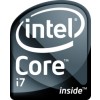- Qualcomm Launches Snapdragon 4 Gen 2 Mobile Platform
- AMD Launches Ryzen PRO 7000 Series Mobile & Desktop Platform
- Intel Launches Sleek Single-Slot Arc Pro A60 Workstation Graphics Card
- NVIDIA Announces Latest Ada Lovelace Additions: GeForce RTX 4060 Ti & RTX 4060
- Maxon Redshift With AMD Radeon GPU Rendering Support Now Available
Intel Core i7 Performance Preview

With Core i7’s launch due in just a few weeks, there’s no better time than right now to take a hard look at its performance, which is what we’re taking care of today. In addition to our usual performance comparisons with last-gen CPUs, we’re also taking an in-depth look at both QPI and HyperThreading performance, and some of our results may surprise you.
Page 10 – System: Sandra Memory, Multi-Core Efficiency
Generally speaking, the faster the processor, the higher the system-wide bandwidth and the lower the latency. As is always the case, faster is better when it comes to processors, as we’ll see below. But with Core i7, the game changes up a bit.
Whereas previous memory controllers utilized a dual-channel operation, Intel threw that out the window to introduce triple-channel, which we talked a lot about at August’s IDF. Further, since Intel integrates the IMC onto the die of the new CPUs, benefits are going to be seen all-around.
Before jumping into the results, we already had an idea of what to expect, and just as we did, the results seen are nothing short of staggering.

Because we are dealing with a dual-channel vs. tri-channel comparison, it’s virtually impossible to have apples-to-apples-type results. The main issue is density, because no matter the RAM configuration you have, you can’t match the same density on both platforms. On Core 2, RAM configs were generally 2GB, 4GB or 8GB. With i7, we have 3GB, 6GB and 12GB (12GB!).
Also, we didn’t receive a proper 6GB kit prior to this article, so improvements to be seen are likely to be a bit better than what’s shown above. This is something we’ll tackle for the final review later this month. As it stands, though, the slower 3GB kit proved over 2x faster in terms of bandwidth than the faster 4GB kit on our Core 2 platform.

In terms of latency, not much has changed, even with the move to an integrated memory controller. These results are probably why when I asked about latency at IDF, I wasn’t given a direct answer. This isn’t a problem, per se, but I definitely expected to see much better results than this. Maybe there will still be a good reason to pick up “performance” kits.
Sandra 2009 Multi-Core Efficiency
How fast can one core swap data with another? It might not seem that important, but it definitely is if you are dealing with a true multi-threaded application. The faster data can be swapped around, the faster it’s going to be finished, so overall, inter-core speeds are important in every regard.
Even without looking at the data, we know that Core i7 is going to excel here, for a few different reasons. The main is the fact that this is Intel’s first native Quad-Core. Rather than have two Dual-Core dies placed beside each other, i7 was built to place four cores together, so that in itself improves things. Past that, the ultra-fast QPI bus likely also has something to do with speed increases.

As we expected, Core i7 can swap data between its cores much faster than previous processors, and also manages to cut down significantly on latency. This is another feature to thank HyperThreading for, because without it, believe it or not, the bandwidth and latencies are actually a bit worse, clock-for-clock, as we’ll see soon.
Support our efforts! With ad revenue at an all-time low for written websites, we're relying more than ever on reader support to help us continue putting so much effort into this type of content. You can support us by becoming a Patron, or by using our Amazon shopping affiliate links listed through our articles. Thanks for your support!





